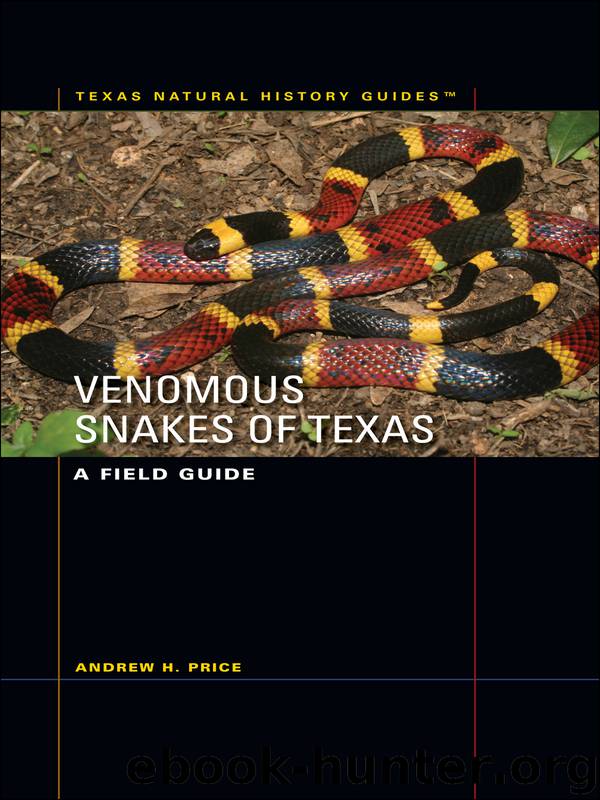Venomous Snakes of Texas by Andrew Price

Author:Andrew Price
Language: eng
Format: epub
Publisher: University of Texas Press
Published: 2009-03-08T16:00:00+00:00
Fig. 26. Mojave rattlesnake (Crotalus scutulatus scutulatus). Photo by Mike Price
Fig. 27. Known occurrences, by county, of the Mojave rattlesnake (Crotalus scutulatus scutulatus).
Fig. 28. Rattlesnake patterning.
HABITAT This species occurs in open creosote-bush desert flats and desert grasslands, generally without rocky soils, at elevations below 5,000 feet (1,515 m).
BEHAVIOR This species is almost always nocturnal during the summer months, but can be found during the day at other times during its activity season, which extends from March through October. It has a reputation for being highly aggressive, which, combined with the increased toxicity of its venom, would place this species at the high end of the danger scale. Fortunately, this reputation is overstated: individuals are just as likely to attempt to escape as they are to assume the characteristic defensive posture of congeners such as the western diamondback rattlesnake. Individuals hibernate singly or in small groups, and may be active at the mouth of hibernacula on warm days.
REPRODUCTION Very little is known about reproduction in this species. Mating may take place at any time during the summer activity season. Females inseminated late during the season may store sperm for use in fertilizing ova after their spring emergence from hibernation. Young are born from July through September, with a peak in August. Litter size averages about 9, with a range of 5–13. A natural hybrid with Crotalus viridis from Hudspeth County has been reported.
PREY AND PREDATORS Although juveniles may take a wide variety of prey, from insects to small mammals, adults eat primarily mammals. In Texas, the Texas banded gecko, spiny lizards, and western whiptail are known to be eaten. In neighboring Chihuahua, Mexico, the black-tailed jackrabbit, desert cottontail, cactus mouse, deer mouse, Merriam’s kangaroo rat, bannertail kangaroo rat, rock pocket mouse, desert pocket mouse, silky pocket mouse, and spotted ground squirrel are on the menu.
VENOM CHARACTERISTICS Venom yields from adults are moderate, based on very limited data, averaging 180–286 mg (dry weight), with a maximum of 540 mg dry weight. There are distinct biochemical and toxicological differences in venoms from different populations throughout the geographic range of this species. The Texas population has the more toxic venom, although this can vary even within the offspring of a single litter. These populations exhibit considerable neurotoxic activity in their venom, with little local edema or tissue damage but significant systemic effects resulting from bites. An average LD50 (ip) of 0.24 mg/kg (0.13–0.54) has been reported for the most toxic venom variety. Comparable values for a less toxic venom variant are 3.0 mg/kg (2.3–3.8). Additional LD50 values reported are 0.12–0.21 mg/kg (iv) and 0.31 mg/kg (sc). The lethal human dose is unknown and undoubtedly variable, but has been estimated at 10–15 mg. This is generally recognized as one of the most dangerous species of rattlesnakes in North America because of its relatively large size, the irritable tendency of certain individuals, and the potency of the venom. The venom is devoid of hemorrhagic and high alkaline phosphomonoesterase activities.
The fangs are relatively long (0.39–0.55 inches [10–14 mm]) in adults.
Download
This site does not store any files on its server. We only index and link to content provided by other sites. Please contact the content providers to delete copyright contents if any and email us, we'll remove relevant links or contents immediately.
Sapiens: A Brief History of Humankind by Yuval Noah Harari(13049)
The Tidewater Tales by John Barth(12029)
Do No Harm Stories of Life, Death and Brain Surgery by Henry Marsh(6335)
Mastermind: How to Think Like Sherlock Holmes by Maria Konnikova(6234)
The Thirst by Nesbo Jo(5784)
Why We Sleep: Unlocking the Power of Sleep and Dreams by Matthew Walker(5640)
Sapiens by Yuval Noah Harari(4534)
Life 3.0: Being Human in the Age of Artificial Intelligence by Tegmark Max(4504)
The Longevity Diet by Valter Longo(4445)
The Rules Do Not Apply by Ariel Levy(3905)
The Immortal Life of Henrietta Lacks by Rebecca Skloot(3826)
The Body: A Guide for Occupants by Bill Bryson(3797)
Why We Sleep by Matthew Walker(3771)
Animal Frequency by Melissa Alvarez(3754)
Yoga Anatomy by Kaminoff Leslie(3700)
Barron's AP Biology by Goldberg M.S. Deborah T(3631)
The Hacking of the American Mind by Robert H. Lustig(3579)
All Creatures Great and Small by James Herriot(3515)
Yoga Anatomy by Leslie Kaminoff & Amy Matthews(3394)
